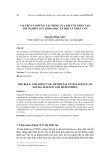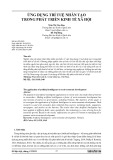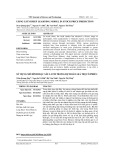
Applying deep learning to forecast the demand of a Vietnamese FMCG companyLe Duc Dao* and Le Nguyen KhoiHo Chi Minh City University of Technology, Vietnam Naonal University, VietnamABSTRACT In the realm of Fast-Moving Consumer Goods (FMCG) companies, the precision of demand forecasng is essenal. The FMCG sector operates in a highly uncertain environment marked by rapid market shis and changing consumer preferences. To address these challenges, the applicaon of deep learning techniques, parcularly Long Short-Term Memory (LSTM) networks, has emerged as a vital soluon for enhancing forecast accuracy. This research paper focuses on the crical role of demand forecasng in FMCG, emphasizing the need for LSTM-based deep learning models to deal with demand uncertainty and improve predicve outcomes. Through this exploraon, we aim to illuminate the link between demand forecasng and advanced deep learning, enabling FMCG companies to thrive in a highly dynamic business landscape.Keywords: demand forecast, ARIMA, deep learning, long-short term memory, FMCGWithin the domain of Fast-Moving Consumer Goods (FMCG), the importance of precise demand predicon remains of paramount significance [1]. The nature of the FMCG industry is represented by swi market fluctuaons and ever-shiing consumer preferences. As product life cycles grow ever shorter and consumers become familiar with greater product variety, FMCG companies face increasing pressure to accurately ancipate future demand in order to opmize producon schedules, inventory levels, supply chain coordinaon, promoonal campaigns, workforce allocaon, and other key operaons that can make profit for them. However, the complex factors influencing product demand in the FMCG space oen proves difficult to model using tradional stascal techniques. Demand drivers may include broad economic condions, consumer confidence, compeve landscape, channel dynamics, weather paerns, commodity prices, cultural trends, and a myriad of other variables that can be difficult to quanfy. While ARIMA (Autoregressive Integrated Moving Average) and other tradional forecasng techniques have been valuable tools for predicon in various fields, they oen struggle to cope with the complexies of today's rapidly changing and highly dynamic world [2]. Such methods rely heavily on historical sales paerns connuing into the future. When condions or consumer preferences shi suddenly, tradional models fail to account for new realies. Consequently, the adopon of advanced deep learning methodologies, parcularly the Long Short-Term Memory (LSTM) networks, has gained prominence as an essenal method for improving the precision of forecasts [3]. LSTMs and related recurrent neural network architectures possess provide advantages in processing me series data, idenfying subtle paerns across long me lags, and adapng predicons based on newly available informaon. Inspired by the workings of human memory, LSTM models can learn context and discard outdated assumpons in light of updates, much as a supply chain manager would aer nocing an impacul new trend. By combining the basic stascal foundaon of methods like ARIMA with the paern recognion capabilies of deep learning, FMCG forecasng stands to become significantly more accurate and responsive to fluctuaons in consumer demand. Stems from the fact that ARIMA's ability to model linear historical paerns and LSTM's ability for uncovering nonlinear relaonships, a combined forecast of ARIMA and LSTM were proposed to guide the direcon of this research, considering the nature of products. Further invesgaons into opmal model architectures, hyperparameter tuning, and 85Hong Bang Internaonal University Journal of ScienceISSN: 2615 - 9686 DOI: hps://doi.org/10.59294/HIUJS.VOL.5.2023.552Hong Bang Internaonal University Journal of Science - Vol.5 - 12/2023: 85-92Corresponding author: Le Duc DaoEmail: lddao@hcmut.edu.vn1. INTRODUCTION

86Hong Bang Internaonal University Journal of ScienceISSN: 2615 - 9686Hong Bang Internaonal University Journal of Science - Vol.5 - 12/2023: 85-92ensemble techniques offer rich potenal to enhance predicve power even in turbulent markets. As the FMCG landscape grows more complex each year, harnessing both stascal and machine learning will only increase in necessity to keep up with the pace of change.2. CASE STUDYThe researched product is pre-packaged, and historical market demand data has been collected from January 2022 to May 2023. The current demand forecast is generated annually, using a one-month me bucket. Consequently, the company has encountered issues related to an excess of finished goods, resulng in overcapacity in the warehouse. These problems have adversely affected supply chain efficiency and financial flow. Days Inventory Outstanding (DIO) is among the key performance indicators used to evaluate the operaonal efficiency of the company. DIO stands for Days Inventory Outstanding and measures the average number of days that a company's inventory is held before it is sold or used up. This metric provides valuable insights into the efficiency of a company's inventory turnover and helps evaluate the effecveness of the supply chain and inventory management process. In fact, the company has encountered a high DIO, around 50 days, with the target of reducing it to about 20 days. DIO is comprised of many factors, one of which is having accurate demand forecasts to ensure on-hand inventory is kept at appropriate levels. Therefore, a comprehensive analysis of demand forecasng is necessary to develop a new forecasng model with the purpose of improving the forecast accuracy for the company. To conduct this analysis, the first step will be data preparaon and cleaning to ensure the demand data is accurate and consistent over the given me period. Stascal analysis such as trend, seasonality and residual decomposion will then be performed to understand the demand paerns. Potenal forecasng methods to explore further include me series models like ARIMA models or advanced forecasng technique, including LSTM or the combined model. The parameters and fit of each model will be evaluated to select the one that opmizes error metrics like MAPE, MSE, MAD. Once an appropriate model is selected, it will be tested by forecasng by using the historical demand data. By improving demand planning, the company can beer align producon, inventory and distribuon plans. This will increase supply chain agility, reduce waste, enable cost savings and ulmately provide beer customer service. The overall goal is an integrated and intelligent demand forecasng approach customized for the business based on stascal best pracces.2.1. Data processingData has been collected from January 2022 to May 2023, in a weekly basis (74 observaons). The data then being pre-processed to eliminate error and N/A values. (Detail in Table 1). Table 1. Demand from January 2022 to May 2023Period Demand Period Demand Period Demand Period Demand 1 78102 20 198599 39 140682 58 114350 2 112797 21 135898 40 78210 59 132432 3 132570 22 155856 41 102881 60 119826 4 65469 23 115008 42 104850 61 121932 5 39270 24 212886 43 101356 62 129282 6 120738 25 128238 44 98298 63 148685 7 126173 26 200184 45 103759 64 149196 8 169288 27 117263 46 112511 65 127824 9 180010 28 225381 47 115666 66 189222 10 131364 29 89120 48 108126 67 165828 11 107148 30 154791 49 96533 68 177150 12 177275 31 111870 50 120708 69 198114 13 163092 32 80339 51 129684 70 205284 14 147462 33 176513 52 150497 71 189090 15 154049 34 138088 53 62202 72 138092

87Hong Bang Internaonal University Journal of ScienceISSN: 2615 - 9686 Hong Bang Internaonal University Journal of Science - Vol.5 - 12/2023: 85-92· Data analysisFrom the descripve analysis, the dataset exhibits the following characteriscs: The data ranges from 27,240 to 242,922, with an interquarle range of 109,062 to 155,590 and the presence of two outliers, detected using the 1.5 interquarle range rule [4]. The 1.5 interquarle range (IQR) rule is a stascal method to detect outliers in a dataset. It works by idenfying any data points that fall more than 1.5 mes the range from the first quarle to the third quarle. Points which fall outside those limits usually indicate unusual fluctuaons in demand. Therefore, it is necessary to replace these values using the 1.5 interquarle range rule [4]. The final me series, aer treang the outliers, is shown in Figure 1.The me series has been decomposed in Figure 2. Time series decomposion has enabled us to separate the me series into three main components: trend, seasonality, and residual. From the trend component, it appears that there is a slight upward trend. Seasonality occurs with a period of two, as many retailers tend to import the company's products on a bi-monthly basis. Addionally, numerous irregular fluctuaons in demand result in the variaon of residual data points.16 156886 35 99042 54 114276 73 154218 17 174881 36 117530 55 53964 74 218382 18 98908 37 138040 56 130188 19 142319 38 93319 57 148680 Figure 1. Time series plot aer replacing outliersFigure 2. Time series decomposion

88Hong Bang Internaonal University Journal of ScienceISSN: 2615 - 9686Hong Bang Internaonal University Journal of Science - Vol.5 - 12/2023: 85-922.2. Model selecon and evaluaonThere are many methods that can be used to work well with the me series that has slight trend and seasonality with a strong irregular paer. ARIMA and LSTM models have been widely applied for me series forecasng tasks across domains. For instance, Williams et al [5] have developed seasonal ARIMA models to forecast traffic flow. The models outperformed historical average benchmarks. Ediger et al [6] have applied ARIMA forecast primary energy demand in Turkey by fuel type. The models were able to accurately forecast primary energy demand for each fuel type one to five years ahead, with lower errors than alternave extrapolaon methods. On the other hand, LSTM also being applied in many research. Abbasimehr et al [7] have proposed an opmized LSTM model for product demand forecasng and compare performance against stascal methods. The opmized LSTM model significantly outperforms the stascal methods across all forecast horizons, while the ARIMA and SARIMA performance degrades significantly for longer horizon forecasts. In finance, Jiang et al [8] have developed a LSTM model to predict the stock market. The result states that the LSTM model outperformed the ARIMA model in forecasng stock prices in term of RMSE and MAPE metrics. However, some researches have provided the superiority of a combined LSTM-ARIMA model. G. Peter Zhang [9] has built a hybrid model combining ARIMA and neural networks for me series forecasng. The hybrid ARIMA-NN model significantly outperforms both individual models across all forecast horizons on the two datasets. Similarly, Dave et al [10] have developed a hybrid ARIMA-LSTM model to forecast Indonesia's monthly export values and compare performance to individual models. The ARIMA-LSTM hybrid model provides the most accurate forecasts with lowest MAPE and RMSE scores across all horizons. It improves on individual models by 3-10%. By referring these researches, ARIMA, LSTM and a hybrid ARIMA-LSTM model is selected for this paper.2.2.1. ARIMA modelThe ARIMA model relies on three fundamental parameters-p, d, and q-each represenng a crucial aspect of the forecasng process. The variable “p” corresponds to the count of autoregressive terms (AR), indicang the reliance on past observaons for predicng future values while “d” signifies the number of nonseasonal differences incorporated into the model, capturing the extent of data transformaon needed to achieve staonarity. Lastly, “q” denotes the quanty of lagged forecast errors (MA), reflecng the influence of past errors on the current predicon. By analyzing ACF and PACF plots, opmal parameters are chosen based on the informaon criteria (AIC), so the most suitable model is the ARIMA (4,0,4) [11].The ACF of residuals (Figure 3) shows that there is no lag value that fall outside the significant limits. Furthermore, the p-value (Figure 4) for lag 12, 24, 36, and 48 all greater than 0.05. Therefore, there is not enough evidence to reject the null hypothesis of no autocorrelaon in the residuals, which can conclude that errors are random.Figure 3. The ACF plot of ARIMA's residuals

89Hong Bang Internaonal University Journal of ScienceISSN: 2615 - 9686 Hong Bang Internaonal University Journal of Science - Vol.5 - 12/2023: 85-922.2.2. LSTM modelThe LSTM model operates with disncve parameters that shape its architecture and influence its forecasng capabilies. Essenal elements such as the number of memory cells, layers, and other architectural features play a pivotal role in capturing intricate temporal dependencies within the sequenal data [12]. The LSTM model used in this paper is constructed with a sequenal architecture, featuring input layers with a shape of (4, 1). The core part of the model lies in the LSTM layer with 256 units and a recurrent dropout of 0.2, allowing it to capture temporal dependencies and paerns within the input data. The subsequent dense layers, each with 64 units and ReLU acvaon, add non-linearity to the model, enhancing its capacity to learn complex relaonships. The model is designed to predict a single output. During training, the mean squared error (MSE) is employed as the loss funcon, with the Adam opmizer ulizing a learning rate of 0.005. The model's performance is evaluated using mean absolute error as a metric. Training occurs over 200 epochs, with a batch size of 32. This architecture, through its LSTM structure and subsequent dense layers, is tailored to effecvely capture and learn intricate paerns within sequenal data, making it a potent tool for forecasng and predicon tasks. 2.2.3. The hybrid ARIMA-LSTM modelIn general, both ARIMA and LSTM models have demonstrated success within their respecve linear or nonlinear domains, but these methods can't be applied to all scenarios. ARIMA's approximaon capabilies may fail to address complex nonlinear challenges, while LSTM, although suitable for handling both linear and nonlinear me series data, are hindered by prolonged training mes and a lack of clear parameter selecon guidelines [10]. Recognizing the limitaons of each model, a hybrid approach is employed, leveraging the individual strengths of ARIMA and neural networks. This hybrid model aims to enhance predicon accuracy by allowing the models to complement each other, overcoming their individual weaknesses. This strategy recognizes the composite nature of me series, considering a linear autocorrelaon Figure 4. The modified Box-Pierce Chi-Square stasc resultFigure 5. The LSTM model





![Ứng dụng ChatGPT trong kinh doanh của doanh nghiệp: Giải pháp [Mô tả lợi ích/tính năng]](https://cdn.tailieu.vn/images/document/thumbnail/2025/20250314/viaburame/135x160/6981741946749.jpg)











![Đề kiểm tra Quản trị logistics [mới nhất]](https://cdn.tailieu.vn/images/document/thumbnail/2025/20251015/2221002303@sv.ufm.edu.vn/135x160/35151760580355.jpg)
![Bộ câu hỏi thi vấn đáp Quản trị Logistics [năm hiện tại]](https://cdn.tailieu.vn/images/document/thumbnail/2025/20251014/baopn2005@gmail.com/135x160/40361760495274.jpg)







